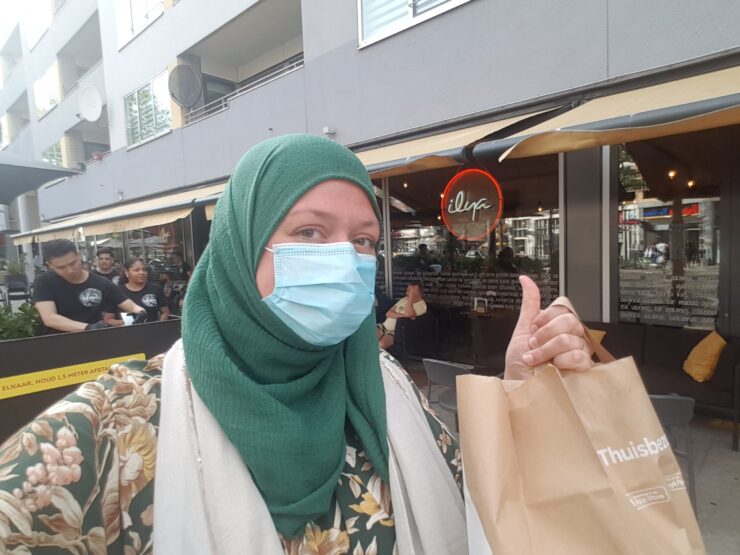Margreet van Es
It is a warm and sunny afternoon when I walk along the West-Kruiskade in Rotterdam. Today is the first of June, the day when cafes and restaurants are finally allowed to open again.[1] The West-Kruiskade is famous for its cultural diversity and its wide variety of restaurants: from Chinese eateries to Moroccan restaurants, and from Japanese ramen shops to halal steakhouses. Everywhere I walk, I notice the relaxed and cheerful atmosphere. Most tables outside are taken. Many people are enjoying a drink, others are ordering dinner. They have had to wait for this for months, and they seem to enjoy every minute of it. On social media, restaurant owners are celebrating the occasion with special offers and festive Instagram posts. At Ilya restaurant, I pick up my order: two hamburger menus for take away. After a short chat with the owner, I get back in the car and go home.

The corona crisis makes us acutely aware of many little pleasures in life that we used to take for granted, but that suddenly became impossible two-and-a-half months ago. One of these things is the opportunity to dine out in a restaurant of our choice as long as our budget allows it. As part of the ‘intelligent lockdown’ that has been implemented in the Netherlands, all cafes and restaurants were closed for visitors upon government orders between March 15th and June 1st. Food could only be ordered for take away or home delivery. For restaurant owners, this meant a massive financial blow. Some restaurant staff lost their jobs. For many consumers, the closing of cafés and restaurants meant that a fundamental aspect of their social and recreational life suddenly disappeared.
As such, the Corona crisis reveals something that we may normally not give much thought to: going out for dinner is about much more than just the food. In a previous blog, I argued that restaurants can be seen as ‘aesthetic formations’ (Meyer 2009): they are meeting points that stimulate all our senses. Not only the food, but also the interior design, the table setting and decoration, the lights, the music, and the service offered by the staff offer a complex whole of sensory experiences that are to induce a mix of allurement, excitement, comfort and belonging. Moreover, these are social experiences: sharing these sensory experiences with other people at our table affects our bond with these people. To put it simply: eating a perfectly-grilled steak from a plastic box at home is not the same as eating the same steak together with friends in one’s favorite restaurant.
In my current research project, I focus on Muslim-owned restaurants in Rotterdam that serve halal-slaughtered meat, do not serve alcohol, and where people can sit comfortably and have dinner in a trendy interior. One of these restaurants is Ilya, which I mentioned above. Although they attract a diverse audience, most customers are young Muslim urban professionals.
Under normal circumstances, these restaurants are the places where friends meet for a night out, where young couples go on a date, where families go when they have something to celebrate, and where famous influencers take their best Instagram photos. This also applies to the month of Ramadan. In previous years, most of these restaurants served a special iftar buffet after sunset. For a fixed price, people could serve themselves with dates, milk or tea, soup, and a few specialties from the regular menu. These buffets were so popular that it was impossible to get a table without making a reservation well in advance.
This year, the Corona crisis changed everything. In the short conversations I had with a few restaurant owners, many of them displayed an ethic of entrepreneurial resilience that is considered typical for Rotterdam, combined with an Islamic ethic of patient endurance in difficult times.
Most of the restaurants that I follow switched to selling iftar boxes for take away. At Madera House, a halal steakhouse located next to Ilya at the West-Kruiskade, customers could choose between calf spareribs, roasted chicken filled with vegetables, Italian pasta with seafood, or a skewer with chicken and beef. All were served with dates, Moroccan harira soup, a chicken or fish bestilla, and (for a surcharge) an alcohol-free mojito.
The owner of Kandinsky Steakhouse, located at Westblaak in the city center, chose a different strategy. He quickly decided to rebuild part of his restaurant into a gold and marble decorated pastry shop, with staff wearing professional white baker’s outfits. Until late after midnight, people could buy croissants, donuts, smoothies, cheesecakes, Moroccan chebakia, Turkish baklava, ice cream, and small elegant pastries ‘as can be seen in Dubai’.
With the re-opening of cafes and restaurants a new phase has begun. How the Corona crisis affects the Rotterdam restaurants in the long run, only time will tell. In any case, the crisis has revealed the creativity of restaurant owners and their customers in finding ways to maintain familiar practices in new circumstances.
This blog is a part of ‘Dossier Corona’, introduced by Religious Matters in the spring of 2020.
References
[1] According to the rules set by the Dutch authorities, cafes and restaurants are allowed to re-open as long as they do not let more than thirty customers in at a time. These customers are obliged to make a reservation beforehand. There are no restrictions on the number of people sitting outside on their terraces, but tables have to be 1,5 meters apart and can be used by people from one household only.

